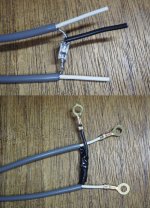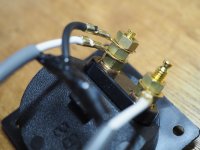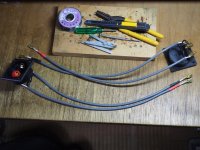I have bookshelf speakers with Alpair 7.3 drivers that I built about 5 years ago. Looks like I used a small diameter stranded wire. I don't think that this was correct. What should I have used? Thanks.
For less than two feet you can use 18 to 16 gauge high purity stranded copper wire. That’s good for up to 50 watts or so. If you are using really heavy speaker wire it makes no sense to use really thin wire in the cabinet.
It looks like maybe 22 ga.
The length of 'skinny' connecting wire inside a speaker cabinet is so short that it introduces an insignificant amount of resistance to the flow of current.
It is in the longer run between the amplifier and the speaker where the benefits of using a thicker wire to reduce resistance are obtained.
Using too thick a wire internally can cause problems in crimping or soldering the thick wire to the driver terminals as well as putting undue stress on the terminals due to the weight of the cable.
I have used bog standard, 16 gauge, 42 strand, PVC insulated copper wire. It has a resistance of only 0.02 ohm per metre.
If your speakers are 8 ohm your 22 (?) gauge wire will be adequate for the internal wiring.
If your speakers are 4 ohm you may like to consider using a smaller gauge number for the internal wiring - 18 gauge would be fine.
If your speakers are 4 ohm you may like to consider using a smaller gauge number for the internal wiring - 18 gauge would be fine.
We use 24g solid pulled from a CAT5/6 cable. A single pair.
Here is the high-end version: https://www.takefiveaudio.com/products/907-neotech-upocc-24-awg-teflon-insulation-cryo-treated/
dave
Here is the high-end version: https://www.takefiveaudio.com/products/907-neotech-upocc-24-awg-teflon-insulation-cryo-treated/
dave
We use 24g solid pulled from a CAT5/6 cable. A single pair.
Ah! The sonic benefits of skinny solid core cable over thicker stranded core cable!
What are they again, Dave? 🙂
What is the reason to tie the outer shield of the + and - cable to one end of the connector ?I use AWG-18 coaxial cable(TPC), which I think is thick enough.
What is the reason to tie the outer shield of the + and - cable to one end of the connector ?
Grounding is done by ladder type cables.
I have used ladder type cables in my small full range and have noticed less distortion at large inputs.
Please refer to the patent site for technical details.
https://laddercable.sakura.ne.jp/oto.html
https://laddercable-sakura-ne-jp.tr..._sl=ja&_x_tr_tl=en&_x_tr_hl=ja&_x_tr_pto=wapp
Greater DDR.
DDR?
I found a debate on DDR here: https://www.diyaudio.com/community/threads/ddr.270493/
Skinny solid core cable allows the driver to faithfully reproduce the low level information in a signal without it being swamped by the high level information?
I presume one could only confirm or deny that through subjective listening tests.
Last edited:
(WiseOldTech waves, and silently leaves perhaps another potentially volitile "cable" discussion)
I presume one could only confirm or deny that through subjective listening tests.
Yes, one can. That is how we got where we did. All with single driver FR speakers with no XO (that first inductor in particular).
DDR is Allen Wright’s if you want to search further.
dave
Allen Wright
He of The SuperCables CookBook fame?
https://www.tnt-audio.com/books/cable_cookbook_e.html
- Home
- Loudspeakers
- Full Range
- What Type/AWG Wire for Binding Post to Speaker Terminals?


